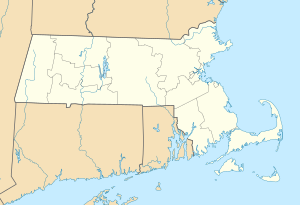Dewey Square Tunnel
|
Dewey Square Tunnel South Station Tunnel
|
||
|---|---|---|
| use | Road tunnel | |
| traffic connection |
|
|
| place | Boston , Massachusetts , United States | |
| length | 2,400 ft (731.5 m ) | |
| construction | ||
| start of building | 1956 | |
| completion | 1959 | |
| business | ||
| operator | Massachusetts Department of Transportation | |
| toll | No | |
| location | ||
|
|
||
| Coordinates | ||
| Chinatown | 42 ° 20 ′ 59 ″ N , 71 ° 3 ′ 35 ″ W. | |
| Congress Street | 42 ° 21 '14 " N , 71 ° 3' 14" W. | |
The Dewey Square Tunnel (also South Station Tunnel ) is a road tunnel in Boston in the state of Massachusetts in the United States . The tunnel runs below the Financial District and the eponymous Dewey Square and leads the streets Interstate 93 , US Highway 1 and Massachusetts Route 3 under the city. At the time of its opening, the tunnel ended on Congress Street , but was expanded in the wake of the Big Dig in a northerly direction and is now part of the Thomas P. O'Neill Jr. Tunnel , which is why the name Dewey Square Tunnel is hardly used anymore becomes.
history
1950s
The tunnel opened in 1959, at the time it was part of the Boston Central Artery Project of the 1950s. The city's residents also referred to it as the South Station Tunnel due to its proximity to Boston South Station . It was created by means of extensive excavations and offered a total of six lanes, ie three in each direction of travel. However, no space was provided for a hard shoulder .
The construction of the largely elevated Central Artery aroused great resentment among the Boston population because it blocked the view and access to the historic waterfront and was otherwise not very pretty. The then Governor John Volpe therefore decided to move the last section of the Central Artery from Congress Street to the border with Chinatown underground. At the time of its opening, the Dewey Square Tunnel was the widest vehicle tunnel in the world.
A bus terminal for the Peter Pan Bus Lines , Bonanza and other regional bus lines was located near the north portal . However, this was moved to the intermodal transport hub Boston South Station .
Big Dig changes
Due to the lack of hard shoulders, the small number of usable lanes and an unmanageable number of access and exit ramps, the tunnel was notorious for significant traffic obstructions and even complete standstill. The authorities were therefore forced to rebuild the Central Artery from scratch and relocate it completely underground. The tunnel was therefore also part of the large-scale Big Dig project in the late 1990s and early 2000s. After the renovation work, the tunnel now only runs in the southern direction of travel of the Central Artery and has a new ventilation system and improved curve radii with an appropriate cross slope . The old north portal on Congress Street was closed in 2005 and connected to the south direction of travel of the new Central Artery . On March 5, 2005, the completely renewed tunnel, which has six lanes at its widest point, was reopened. The Dewey Square Tunnel is the only part of the original Central Artery that is still in use .
Individual evidence
- ^ A b John F. Fitzgerald Expressway. Historic Overview. Bostonroads.com, accessed December 7, 2012 .
